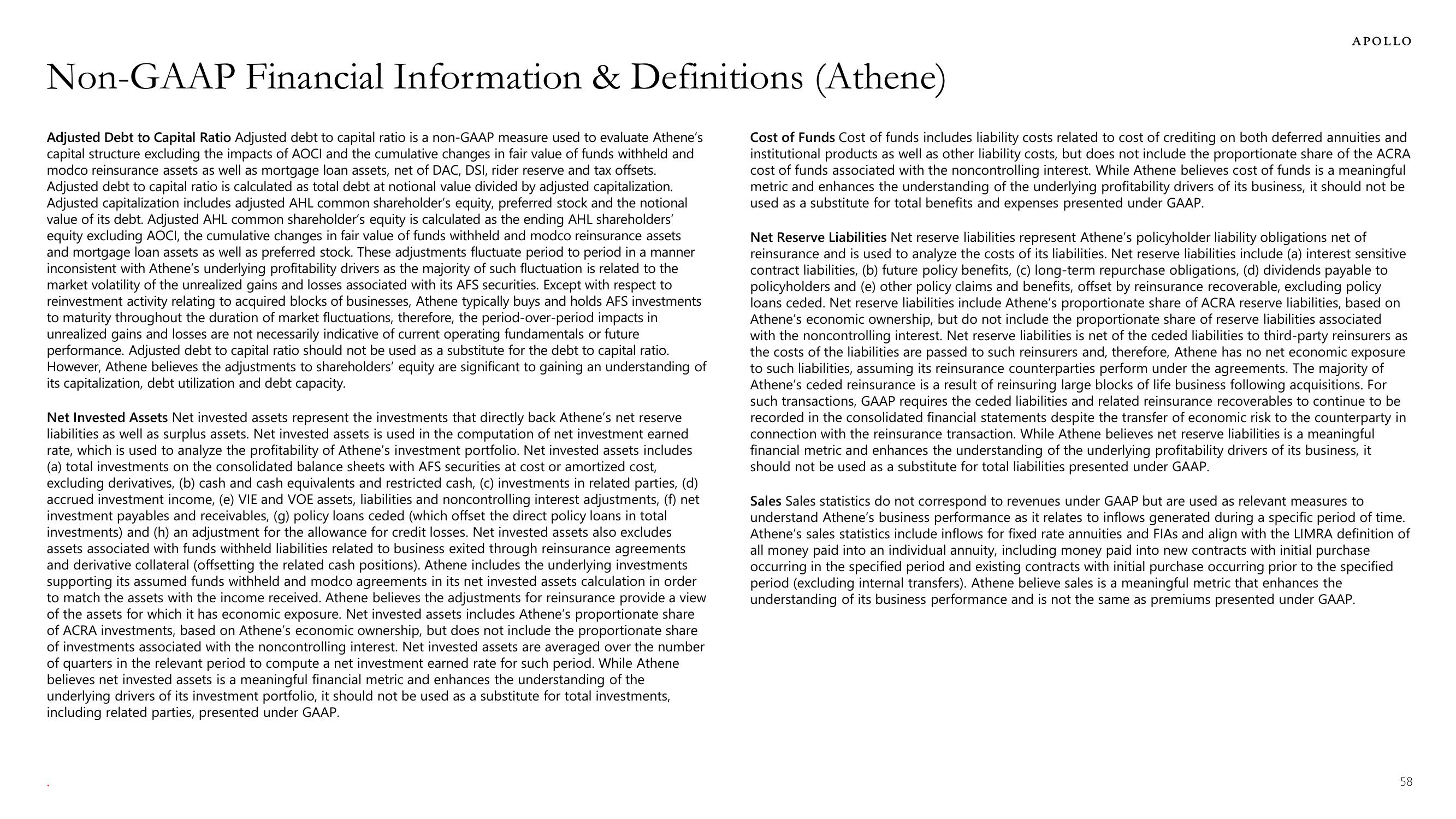Apollo Global Management Investor Presentation Deck
Non-GAAP Financial Information & Definitions (Athene)
Adjusted Debt to Capital Ratio Adjusted debt to capital ratio is a non-GAAP measure used to evaluate Athene's
capital structure excluding the impacts of AOCI and the cumulative changes in fair value of funds withheld and
modco reinsurance assets as well as mortgage loan assets, net of DAC, DSI, rider reserve and tax offsets.
Adjusted debt to capital ratio is calculated as total debt at notional value divided by adjusted capitalization.
Adjusted capitalization includes adjusted AHL common shareholder's equity, preferred stock and the notional
value of its debt. Adjusted AHL common shareholder's equity is calculated as the ending AHL shareholders'
equity excluding AOCI, the cumulative changes in fair value of funds withheld and modco reinsurance assets
and mortgage loan assets well as preferred stock. These adjustments fluctuate period to period in a manner
inconsistent with Athene's underlying profitability drivers as the majority of such fluctuation is related to the
market volatility of the unrealized gains and losses associated with its AFS securities. Except with respect to
reinvestment activity relating to acquired blocks of businesses, Athene typically buys and holds AFS investments
to maturity throughout the duration of market fluctuations, therefore, the period-over-period impacts in
unrealized gains and losses are not necessarily indicative of current operating fundamentals or future
performance. Adjusted debt to capital ratio should not be used as a substitute for the debt to capital ratio.
However, Athene believes the adjustments to shareholders' equity are significant to gaining an understanding of
its capitalization, debt utilization and debt capacity.
Net Invested Assets Net invested assets represent the investments that directly back Athene's net reserve
liabilities as well as surplus assets. Net invested assets is used in the computation of net investment earned
rate, which is used to analyze the profitability of Athene's investment portfolio. Net invested assets includes
(a) total investments on the consolidated balance sheets with AFS securities at cost or amortized cost,
excluding derivatives, (b) cash and cash equivalents and restricted cash, (c) investments in related parties, (d)
accrued investment income, (e) VIE and VOE assets, liabilities and noncontrolling interest adjustments, (f) net
investment payables and receivables, (g) policy loans ceded (which offset the direct policy loans in total
investments) and (h) an adjustment for the allowance for credit losses. Net invested assets also excludes
assets associated with funds withheld liabilities related to business exited through reinsurance agreements
and derivative collateral (offsetting the related cash positions). Athene includes the underlying investments
supporting its assumed funds withheld and modco agreements in its net invested assets calculation in order
to match the assets with the income received. Athene believes the adjustments for reinsurance provide a view
of the assets for which it has economic exposure. Net invested assets includes Athene's proportionate share
of ACRA investments, based on Athene's economic ownership, but does not include the proportionate share
of investments associated with the noncontrolling interest. Net invested assets are averaged over the number
of quarters in the relevant period to compute a net investment earned rate for such period. While Athene
believes net invested assets is a meaningful financial metric and enhances the understanding of the
underlying drivers of its investment portfolio, it should not be used as a substitute for total investments,
including related parties, presented under GAAP.
APOLLO
Cost of Funds Cost of funds includes liability costs related to cost of crediting on both deferred annuities and
institutional products as well as other liability costs, but does not include the proportionate share of the ACRA
cost of funds associated with the noncontrolling interest. While Athene believes cost of funds is a meaningful
metric and enhances the understanding of the underlying profitability drivers of its business, it should not be
used as a substitute for total benefits and expenses presented under GAAP.
Net Reserve Liabilities Net reserve liabilities represent Athene's policyholder liability obligations net of
reinsurance and is used to analyze the costs of its liabilities. Net reserve liabilities include (a) interest sensitive
contract liabilities, (b) future policy benefits, (c) long-term repurchase obligations, (d) dividends payable to
policyholders and (e) other policy claims and benefits, offset by reinsurance recoverable, excluding policy
loans ceded. Net reserve liabilities include Athene's proportionate share of ACRA reserve liabilities, based on
Athene's economic ownership, but do not include the proportionate share of reserve liabilities associated
with the noncontrolling interest. Net reserve liabilities is net of the ceded liabilities to third-party reinsurers as
the costs of the liabilities are passed to such reinsurers and, therefore, Athene has no net economic exposure
to such liabilities, assuming its reinsurance counterparties perform under the agreements. The majority of
Athene's ceded reinsurance is a result of reinsuring large blocks of life business following acquisitions. For
such transactions, GAAP requires the ceded liabilities and related reinsurance recoverables to continue to be
recorded in the consolidated financial statements despite the transfer of economic risk to the counterparty in
connection with the reinsurance transaction. While Athene believes net reserve liabilities is a meaningful
financial metric and enhances the understanding of the underlying profitability drivers of its business, it
should not be used as a substitute for total liabilities presented under GAAP.
Sales Sales statistics do not correspond to revenues under GAAP but are used as relevant measures to
understand Athene's business performance as it relates to inflows generated during a specific period of time.
Athene's sales statistics include inflows for fixed rate annuities and FIAs and align with the LIMRA definition of
all money paid into an individual annuity, including money paid into new contracts with initial purchase
occurring in the specified period and existing contracts with initial purchase occurring prior to the specified
period (excluding internal transfers). Athene believe sales is a meaningful metric that enhances the
understanding of its business performance and is not the same as premiums presented under GAAP.
58View entire presentation